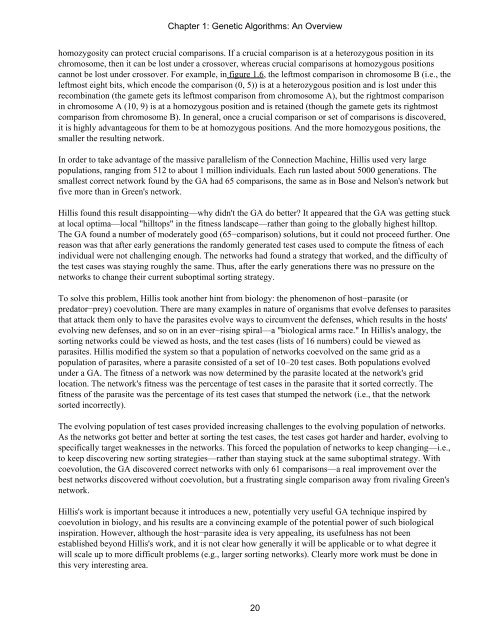An Introduction to Genetic Algorithms - Boente
An Introduction to Genetic Algorithms - Boente
An Introduction to Genetic Algorithms - Boente
You also want an ePaper? Increase the reach of your titles
YUMPU automatically turns print PDFs into web optimized ePapers that Google loves.
Chapter 1: <strong>Genetic</strong> <strong>Algorithms</strong>: <strong>An</strong> Overview<br />
homozygosity can protect crucial comparisons. If a crucial comparison is at a heterozygous position in its<br />
chromosome, then it can be lost under a crossover, whereas crucial comparisons at homozygous positions<br />
cannot be lost under crossover. For example, in figure 1.6, the leftmost comparison in chromosome B (i.e., the<br />
leftmost eight bits, which encode the comparison (0, 5)) is at a heterozygous position and is lost under this<br />
recombination (the gamete gets its leftmost comparison from chromosome A), but the rightmost comparison<br />
in chromosome A (10, 9) is at a homozygous position and is retained (though the gamete gets its rightmost<br />
comparison from chromosome B). In general, once a crucial comparison or set of comparisons is discovered,<br />
it is highly advantageous for them <strong>to</strong> be at homozygous positions. <strong>An</strong>d the more homozygous positions, the<br />
smaller the resulting network.<br />
In order <strong>to</strong> take advantage of the massive parallelism of the Connection Machine, Hillis used very large<br />
populations, ranging from 512 <strong>to</strong> about 1 million individuals. Each run lasted about 5000 generations. The<br />
smallest correct network found by the GA had 65 comparisons, the same as in Bose and Nelson's network but<br />
five more than in Green's network.<br />
Hillis found this result disappointing—why didn't the GA do better? It appeared that the GA was getting stuck<br />
at local optima—local "hill<strong>to</strong>ps" in the fitness landscape—rather than going <strong>to</strong> the globally highest hill<strong>to</strong>p.<br />
The GA found a number of moderately good (65−comparison) solutions, but it could not proceed further. One<br />
reason was that after early generations the randomly generated test cases used <strong>to</strong> compute the fitness of each<br />
individual were not challenging enough. The networks had found a strategy that worked, and the difficulty of<br />
the test cases was staying roughly the same. Thus, after the early generations there was no pressure on the<br />
networks <strong>to</strong> change their current suboptimal sorting strategy.<br />
To solve this problem, Hillis <strong>to</strong>ok another hint from biology: the phenomenon of host−parasite (or<br />
preda<strong>to</strong>r−prey) coevolution. There are many examples in nature of organisms that evolve defenses <strong>to</strong> parasites<br />
that attack them only <strong>to</strong> have the parasites evolve ways <strong>to</strong> circumvent the defenses, which results in the hosts'<br />
evolving new defenses, and so on in an ever−rising spiral—a "biological arms race." In Hillis's analogy, the<br />
sorting networks could be viewed as hosts, and the test cases (lists of 16 numbers) could be viewed as<br />
parasites. Hillis modified the system so that a population of networks coevolved on the same grid as a<br />
population of parasites, where a parasite consisted of a set of 10–20 test cases. Both populations evolved<br />
under a GA. The fitness of a network was now determined by the parasite located at the network's grid<br />
location. The network's fitness was the percentage of test cases in the parasite that it sorted correctly. The<br />
fitness of the parasite was the percentage of its test cases that stumped the network (i.e., that the network<br />
sorted incorrectly).<br />
The evolving population of test cases provided increasing challenges <strong>to</strong> the evolving population of networks.<br />
As the networks got better and better at sorting the test cases, the test cases got harder and harder, evolving <strong>to</strong><br />
specifically target weaknesses in the networks. This forced the population of networks <strong>to</strong> keep changing—i.e.,<br />
<strong>to</strong> keep discovering new sorting strategies—rather than staying stuck at the same suboptimal strategy. With<br />
coevolution, the GA discovered correct networks with only 61 comparisons—a real improvement over the<br />
best networks discovered without coevolution, but a frustrating single comparison away from rivaling Green's<br />
network.<br />
Hillis's work is important because it introduces a new, potentially very useful GA technique inspired by<br />
coevolution in biology, and his results are a convincing example of the potential power of such biological<br />
inspiration. However, although the host−parasite idea is very appealing, its usefulness has not been<br />
established beyond Hillis's work, and it is not clear how generally it will be applicable or <strong>to</strong> what degree it<br />
will scale up <strong>to</strong> more difficult problems (e.g., larger sorting networks). Clearly more work must be done in<br />
this very interesting area.<br />
20






